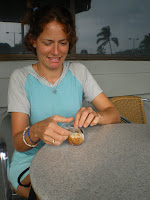What comes to mind when you think of Hawaiian food? If you’re like me, you conjure up images of fresh fruits (bananas and pineapples being the most prolific in the image, but generally anything that will fit on top of the Tropicana girl’s head will do), seafood (Hawaii is, after all, in the middle of the Pacific ocean), and exotic luau dishes like steamed taro leaves and roast pig.
In reality, Hawaii’s cuisine is both much more and much less than what the stereotypical image beholds. Bananas and pineapples abound, in addition to avocados (which grow in most backyards), passion fruit, guavas, and a host of other exotic fruits that are beyond many an imagination. Becoming acquainted with the amazing variety of fruit grown in Hawaii takes a courageous and adventurous spirit, but one that will be rewarded with unparalleled food experiences.
Move away from the agricultural parts of Hawaii though, and you see much less of the exotic fruits and much more….well….Spam.
Hawaii is the Spam capital of the USA, with almost 11,000 cans being consumed per day. Per day. Hawaii is just not that big either. That’s a lot of Spam. Walk into the grocery store, and you’ll see spam on rice (served sushi-style, and called musubi), spam hot plates, and of course, cans upon cans of the stuff. McDonalds offers Spam-based breakfasts, and most local restaurants have some sort of Spam delicacy on the menu.
And the locals lap this stuff up like it’s going out of style. Shhh…don’t tell them it already went out of style – decades ago.
The history of Spam in Hawaii is actually up for interpretation. Some say that it dates back to the Second World War, where provisions like Spam were necessary for troops and easy to transport, henceforth becoming rampant and popular in Hawaii with lots of left-over stock to enjoy. Others suggest it dates back to the plantation days, as an easy alternative to meat which wasn’t always available. And others yet suggest that Spam simply goes well with rice – another Hawaiian specialty.
So in the spirit of adopting various cuisines around the world wholeheartedly, I decided to make a valiant attempt with Spam in Hawaii.
Hawaiians only eat Spam cooked (god forbid they should eat such gruel right out of the can). And I’ll admit, walking by the array of musubi in the grocery store kept warm under the heat lamps along with rotisserie chicken, my eyes have strayed off course more than once. And as a sushi-lover, anything with sushi rice and seaweed can’t be that bad, can it?
So purely as an experiment for the purposes of writing this article, I purchased a piece of musubi for $1.75. For my two dollars, I received a large bed of sushi rice, a 1/4 inch slice of fried Spam, and some sort of teriyaki sauce, all held together with nori (seaweed).
As I left the store, warm musubi in my hand, I was actually excited. No really. I had heard so much bad stuff about Spam, but somehow I figured that if it was cooked it would end up something like ham.
Can you see where this is going yet?
After excitedly fiddling with the iron-clad plastic wrap, I finally unearthed my prize. Okay – one, two, three…
My first bite had more rice and nori than it did Spam. I mulled it over and around in my mouth, and although it didn’t rock my world, I didn’t mind it either. The next bite, however, had more Spam content. The way it mysteriously dissolved in my mouth was upsetting enough, but then the subtle taste of – what was it? bile? Or the taste of dog food? Or both? – allowed me to graciously set my Spam musubi down, never to pick it up again. Actually that’s not quite true: I ate most of the rice and nori around the Spam, careful to leave the Spam-contaminated grains of rice alone.
Much of what we eat and how we perceive it is mental. Had I not grown up in a cultural environment that made fun of Spam, and were I not a nutritionally conscious person who actually reads ingredients labels, I might have been able to down the musubi without a second thought. And surely, in other places of the world, I expect to eat much worse, with a big smile on my face and many gracious nods of approval all around.
But here, in an extremely remote corner of the USA, with an environment so close to everything I already know, even the most adventurous eater in me was unable to “swallow” the idea that Spam is a cultural part of Hawaiian cuisine.
This post was originally published in 2008. It has since been updated for accuracy of links and content.
Check out my Travel Lifestyle Guides for more ways to earn money remotely, spend it wisely, and balance the two so you can travel as long as you wish, in a financially sustainable way.



